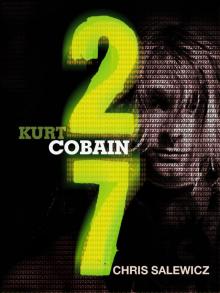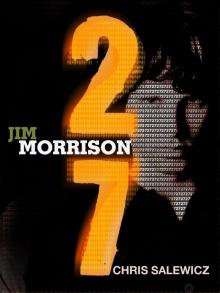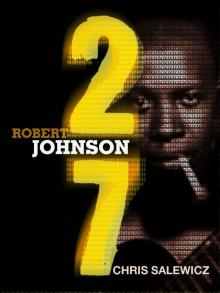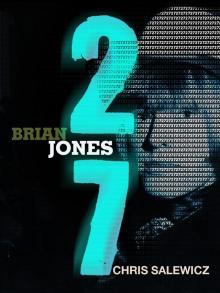- Home
- Salewicz, Chris
27: Jim Morrison Page 4
27: Jim Morrison Read online
Page 4
In Los Angeles in August 1967 they recommenced recording their second album. Jim Morrison had already declared in a radio interview that it would be called Strange Days. There was already an advance order of 500,000 for the as yet unrealized record.
In an article written while they were making the album, the celebrated writer Joan Didion observed, with considerable prescience, that Jim Morrison was suggesting ‘some range of the possible just beyond a suicide pact’.47
There were lighter moments. Like the Manhattan photo shoot for Vogue in September 1967. The pictures were taken by 24-year-old Baron Alexis Alfonse von Gecman Waldeck in his Chelsea loft for that December’s edition of the upmarket fashion magazine. ‘In Jim Morrison I saw a peasant,’ Waldeck told Crawdaddy magazine. ‘He could be a Russian peasant. I would love to photograph him in a wheat field in a wagon, with an open shirt. There’s similarity between Nureyev and Morrison. There’s that pride – you know, very much Self. They both like to see themselves. Morrison loves himself.’
The photographer’s shots were complemented by words from the New York writer Albert Goldman in which he waxed lyrical about Jim Morrison as ‘the one authentic sex hero of the current generation … the most admired figure on the American rock scene.’ (In Feast of Friends, the documentary about The Doors directed by – among others – Jim Morrison, Goldman, a great champion of the group, is in the very first scene, in footage showing The Doors singer speaking with him in a limousine. Goldman would go on to write hugely successful – and controversial – biographies of Lenny Bruce, Elvis Presley and John Lennon, and at the time of his death was working on a biography of Morrison.)
More than anything, it was these unexpectedly dignified Vogue images that led to the transmogrification of Jim Morrison, singer with The Doors, into Jim Morrison the Sex Symbol. ‘If my antenna are right he could be the biggest thing to grab the mass libido in a very long time. I have never seen such an animalistic response from so many different kinds of women,’ wrote Village Voice columnist Howard Smith.48
‘The quality Morrison has got,’ considered Gloria Staver, the editor of the million-selling 16 magazine, with whom Jim had already had a fling. ‘The teenagers see their thing, the secretaries in my office have become entranced by him, the New York hippies at the Fillmore dig him. There’s something for everybody. But it’s still Whole. He walks through the fire and he comes out Whole.’49
On that same visit to New York, on 17 September 1967, The Doors appeared on the almost mythical Ed Sullivan Show. They were to perform ‘People Are Strange’ from the imminent Strange Days album, and ‘Light My Fire’, their number one hit single from the first LP. Minutes before their performance, a producer came to their dressing room: the ‘Light My Fire’ line ‘Girl, we couldn’t get much higher’ would need to be changed to ‘Girl, we couldn’t get much better’. The Doors appeared to agree to this. Except that when Jim Morrison sang the song live on national television, he stuck to the original version of the lyrics. Afterwards the production staff informed the group that they had been ready to book them on a further six shows. Now, however, they were banned from The Ed Sullivan Show, seemingly forever.
Strange Days, for which the Vogue photo shoot and the Ed Sullivan Show performance had served as promotion, was in the stores in the United States on 25 September, less than nine months after the group’s first LP had been released. Put out as a single, ‘People Are Strange’ scraped the Top 10, but failed to emulate the number one status of ‘Light My Fire’. ‘Love Me Two Times’, the second single off Strange Days, only made 25 – although we will come to the curious circumstances behind this. The lack of a smash hit 45 was used as an explanation for why Strange Days never made it higher than the number three album slot. Memorable for its distinctive cover – featuring none of the group and shot in a New York alley – if anything, the record was even better than The Doors. As though it was competing with the eleven-minute version of ‘The End’ that concluded the first album, Strange Days had another eleven minute final tune. ‘When the Music’s Over’ was an early pro-ecology epic of considerable insight:
What have they done to the earth?
What have they done to our fair sister?
Ravaged and plundered and ripped her and bit her
Stuck her with knives in the side of the dawn
And tied her with fences and dragged her down.’
But does ‘When the Music’s Over’ possess the majesty of the impossible-to-emulate ‘The End’? Perhaps not.
On Sunday 27 August 1967, The Doors had played at the Cheetah, a venue on Santa Monica Pier. Before an audience of 2,000, Jim Morrison had deliberately fallen off the stage, to be caught by the audience. Towards the end of 1967 in live shows he was moving much more spontaneously on stage as he performed his visionary, shamanic act. At the beginning of December, however, a far darker force moved into his life.
On Saturday 9 December 1967 The Doors played in New Haven, Connecticut. While making out with an 18-year-old local girl in a backstage shower stall prior to the show, Jim was interrupted by a cop who opened the door. Seeming to believe the singer was a member of the audience who had somehow snuck backstage, the officer ordered him to leave the room. As he would, Jim told the cop to fuck off. For this response, the policeman sprayed mace into the singer’s eyes. In pain, Jim Morrison ran screaming to the group’s dressing room. Bill Siddons then emerged to inform the cop of his error. The officer apologized, although such regret begs the question as to why he would have felt entitled to mace a member of the audience? As a metaphor for a jagged schism in an egregiously conflicted nation, in which lines were distinctly being drawn between ‘straight’ and ‘non-straight’ society, it is compelling. (Might one also not muse on Jim Morrison’s awkward relationships with uniformed authority? Did such figures in any way trigger nerves that reminded him of his naval officer father?)?
As though in some absurdist cartoon of precisely how not to behave at such events, local police hovered on the edge of the New Haven stage. During The Doors’ last number, ‘Back Door Man’, Jim Morrison – who had performed the concert with stinging red eyes – told the audience the tale of what had happened backstage prior to the show. Now he taunted the police. Thrusting his mike under the nose of one of them, he commanded: ‘Say your thing, man!’ Almost immediately, the house lights were switched on. Police stepped forward, arresting the singer and dragging him offstage – the first time this had ever happened to an artist in the United States. The hall erupted with fury. In the ensuing riot by the audience, many fans were also arrested.
Taken to a local police station, Jim Morrison was charged with ‘breach of the peace, resisting arrest and indecent or immoral exhibition’. Further arrests were made as angry protesters gathered outside the police station. At two in the morning, The Doors singer was released from the station on a bail bond of $1,500. A trial was set for the next month.
They had started the year on the high of the release of their first album, The Doors. By the end of 1967, The Doors’ singer seemed briefly to have become Public Enemy Number One.
After the New Haven incident, and despite the fact that all charges against the singer were very quickly dropped, the FBI opened a file on Jim Morrison. Like the actions of the mace-spraying patrolman, the fallout from this incident further highlighted the cultural schism in the United States. And that New Haven drama had another down side; although Jim Morrison should have been deemed innocent until found guilty, this was not the response of the nation’s radio schedulers. ‘Love Me Two Times’, the second single off the Strange Days album, was heading up the charts, only to stumble and be held at no higher than the number 25 slot – in the wake of the onstage arrest, The Doors were temporarily banned from further AM radio play. And there was a nasty fallout within the group itself. Robby Krieger expressed to John Densmore50 the extreme dislike that he now felt for Jim Morrison and how it seemed as though the group’s other three members had now become his babysitters. As though to achi
eve a clearer perspective on their lives, Robby Krieger and John Densmore took a month’s leave of absence from The Doors. They decided to undertake an advanced Transcendental Meditation course of some rigour in the presence of the Maharishi Mahesh Yogi. Around the same time they enrolled in Los Angeles’s newly opened Ravi Shankar Kinara School of Indian Music.
Were The Doors’ drummer and guitarist readying themselves for the group’s next phase? For there was no time for hanging around – within the space of a year The Doors had become the biggest American group, and their workload was becoming more relentless. Yet the by now familiar brouhahas in which the group’s singer seemed to become snared showed little sign of abating. In Las Vegas on 29 January 1968, in the parking lot of the Pussy Cat A Go Go, Jim Morrison feigned smoking a joint in front of a security guard. The guard called over colleagues and Morrison and Bob Grover, a New York Times journalist who was with him, were given a beating. Police were called and the singer was charged with ‘vagrancy, public drunkenness and failure to possess sufficient identification’. In an article subsequently written by Grover, he remarked of Jim Morrison: ‘His charisma was such that your ordinary upholder of the established order could be infuriated merely by the sight of Morrison strolling down the street – innocent to all outward appearances but … well there was that invisible something about him that silently suggested revolution, disorder, chaos.’51
On Monday 19 February 1968, the group went into Hollywood’s TTG recording studios, at the junction of Sunset and Highland, to begin sessions for their next album. An entire side of the album was to be filled with Jim’s poem ‘The Celebration of the Lizard’. Yet the group’s three principal musicians paid such attention to the instrumental pieces that much of the desired cohesion between them and the vocals became lost. Ultimately the notion of recording ‘The Celebration of the Lizard’ was abandoned.
When sessions resumed at the beginning of March, Jim Morrison showed a clear disinclination to participate in the recording process. One day he arrived in the pink Jaguar E-type of actress Sable Sperling. He was clutching a bottle of Wild Turkey and they were both on downers, the singer claiming to have swallowed some twenty Quaaludes. Jim Morrison was supposed to be there to perform the vocals on ‘Love Street’ and ‘Summer’s Almost Gone’. Unfortunately Jim could barely stand. He declared that he didn’t want to sing those songs and would perform ‘Five to One’ instead.52 Although everyone – especially Rothchild – expected him to keel over at any moment, he nailed the take. Ray Manzarek had noticed what seemed to be a birthmark on Sable Sperling’s shapely thigh; perusing it more closely, he saw it was a long, swollen bruise. What had happened? he asked her. Oh, she replied, Jim had hit her with a plank of wood.
This was by no means the only occasion that Jim Morrison turned up drunk at TTG. He was frequently accompanied by other extremely odd people. One day he arrived with a woman who looked like the as yet unknown Charles Manson; Jim’s friends pulled up her skirt and offered the assembled company the opportunity to enjoy themselves in her anus.53 Such incidents made John Densmore declare his intention to quit the group. Paul Rothchild told him he was worried that Jim Morrison would not last long.
Midway through the sessions, Jim Morrison cut off much of his hair, badly and unattractively, as if to represent his psyche.54 Paul Rothchild summoned a band meeting. ‘Jim … you don’t seem interested in participating much in the recording of this album. What are you doing? You don’t look like a rock star anymore.’ ‘Stop him?’ Rothchild responded later to a question from the writer Vic Garbarini.55 ‘Everybody tried to stop him. You couldn’t. Strangers would stop him on the street and try to help him. We all tried to stop him. If you’d know Jim for even ten seconds, you’d know one thing: he was unstoppable. He was his own motive force, an astounding human being. There was no stopping him.’
In an interview to promote the new record, Robby Krieger remarked: ‘There was a lot of Jim getting drunk and bringing drunken friends into the studio and Paul throwing them out. Scenes, heavy pill-taking and stuff. That was rock ’n’ roll to its fullest.’56
By early March 1968, however, the studio sessions had been put to one side as The Doors headed for the East Coast and an epochal set of shows, including their performances at the Fillmore East. This was the period when, to the annoyance of Janis Joplin, Jim Morrison stumbled onto the stage at the Scene club in Manhattan as Jimi Hendrix played with The Young Rascals.
By the time they returned to the recording studio in Los Angeles, the idea of recording ‘The Celebration of the Lizard’ had been scrapped – although the ‘Not to Touch the Earth’ section was retained. The group had agreed to fund the Feast of Friends documentary.
This documentary was an opening salvo in a bid for independence by The Doors. In April, with an advance from Elektra, they bought out their management team, who were replaced by Bill Siddons, their nineteen-year-old tour manager. They opened an office in West Hollywood at 8512 Santa Monica Boulevard, near the junction with La Cienega. Not long after this, Jim walked into the new offices and announced to Ray Manzarek, ‘I wanna quit.’57 He told Ray he thought he was having a nervous breakdown. The keyboard player suggested this frame of mind might have something to do with being drunk all the time. And Ray persuaded him to hang on for another six months.
The recording process for what became known as Waiting for the Sun was arduous and painful – at times like tooth extraction, Paul Rothchild obsessing over every possible sound glitch. (John Densmore felt this may have had something to do with a jar labelled ‘KD’ that Rothchild kept behind his console: ‘KD’ stood for ‘Killer Dope’.)
By the end of April, the new album was finally ready for release. Although it was named after the tune ‘Waiting for the Sun’, that song would not appear until 1970’s Morrison Hotel.
In March the first 45 was issued, the controversial ‘The Unknown Soldier’ with its critical references to the Vietnam war. Considering the political climate in the United States, it was amazing the song received any airplay whatsoever. However, it managed to scrape into the Top 40, peaking at 39.
Early in June, the second single was released from the new album: ‘Hello, I Love You’, coupled with ‘Love Street’.
The release of ‘Hello, I Love You’, one of the songs on The Doors’ original demo, also met with considerable controversy, but of another kind altogether. The Doors were criticized for the release of what was condemned as an outright commercial song, possibly stolen from The Kinks’ ‘Tired of Waiting’, and clearly aimed at the hit parade. Which, of course, it was: why on earth else would a song be chosen as a single? But it was simultaneously a perfect piece of garage band punk, driven by Manzarek’s thrusting keyboards and the singer’s powerful liquid baritone, and climaxing in Morrison’s war whoops. And it achieved the desired effect: ‘Hello, I Love You’ stealthily crept up the charts until, on 3 August, it was the number one single in the United States, staying in this chart position for two weeks. (Also in the US Top 5 at that time was José Feliciano’s version of ‘Light My Fire’. Paradoxically, it was the success of their own version of ‘Light My Fire’ that had polarized their audience. Were The Doors a Top 40 hit act or proselytizers for the revolution – whatever that revolution was?)
After the release of Waiting for the Sun on 12 July 1968, album sales were bolstered by the success of ‘Hello, I Love You’ and it went to number one in the US album charts the same week that the single hit the top slot. (The Doors had now become internationally successful – both ‘Hello, I Love You’ and Waiting for the Sun made the UK Top 20s.)
A string of major North American dates in arena-sized venues promoted the new album. On 5 July 1968, The Doors topped the bill at the Hollywood Bowl in Los Angeles, selling out all 18,000 seats. The show was recorded for the Feast of Friends film. The group were joined by Mick Jagger and music producer Jimmy Miller for a pre-show dinner at Mu Ling’s Chinese restaurant. Whether or not he was weighted down by his extensive helping of food,
Jim Morrison gave a distinctly underwhelming performance. His vocals were impeccable, but he stood static by the microphone, with none of the stage movements by now expected by The Doors’ audience. ‘They (The Doors) were nice chaps, but they played a bit too long,’ said Mick Jagger following the show.
These dates were followed up by The Doors’ first trip to Europe, for shows in England, Germany, Denmark, Sweden and Holland. The London concerts, at underground temple the Roundhouse, on Friday 6 and 7 September, were great triumphs, some of their best ever performances. There were two shows each day: on night one, they supported Jefferson Airplane; on night two, it was the other way around. ‘The audience was one of the best we’ve ever had,’ said the singer. ‘Everyone seemed to take it so easy. It’s probably the most informed, receptive audience I’ve ever seen in my life.’
In Amsterdam Jim Morrison was indisposed. That morning while they had been in Germany he had eaten a lump of Lebanese hash given to him by Bob ‘the Bear’ Hite of Canned Heat. Arriving in Amsterdam, Jim had danced on stage during the Airplane set. But then the hash kicked in and he was unable to perform his role as The Doors’ singer during their own set.
After the European tour, Jim Morrison and Pamela Courson rented a flat in London’s Belgravia and remained there for a month. There they were visited by Michael McClure, the Beat poet and writer. He wanted Jim to play the part of Billy the Kid in a movie to be made of his play The Beard. While at their London lodgings, McClure came across a copy of Jim’s poetry. He was impressed and suggested Jim Morrison publish a private edition, entitled The Lords and the New Creatures.

 27: Kurt Cobain
27: Kurt Cobain 27: Jim Morrison
27: Jim Morrison 27: Robert Johnson
27: Robert Johnson 27: Brian Jones
27: Brian Jones